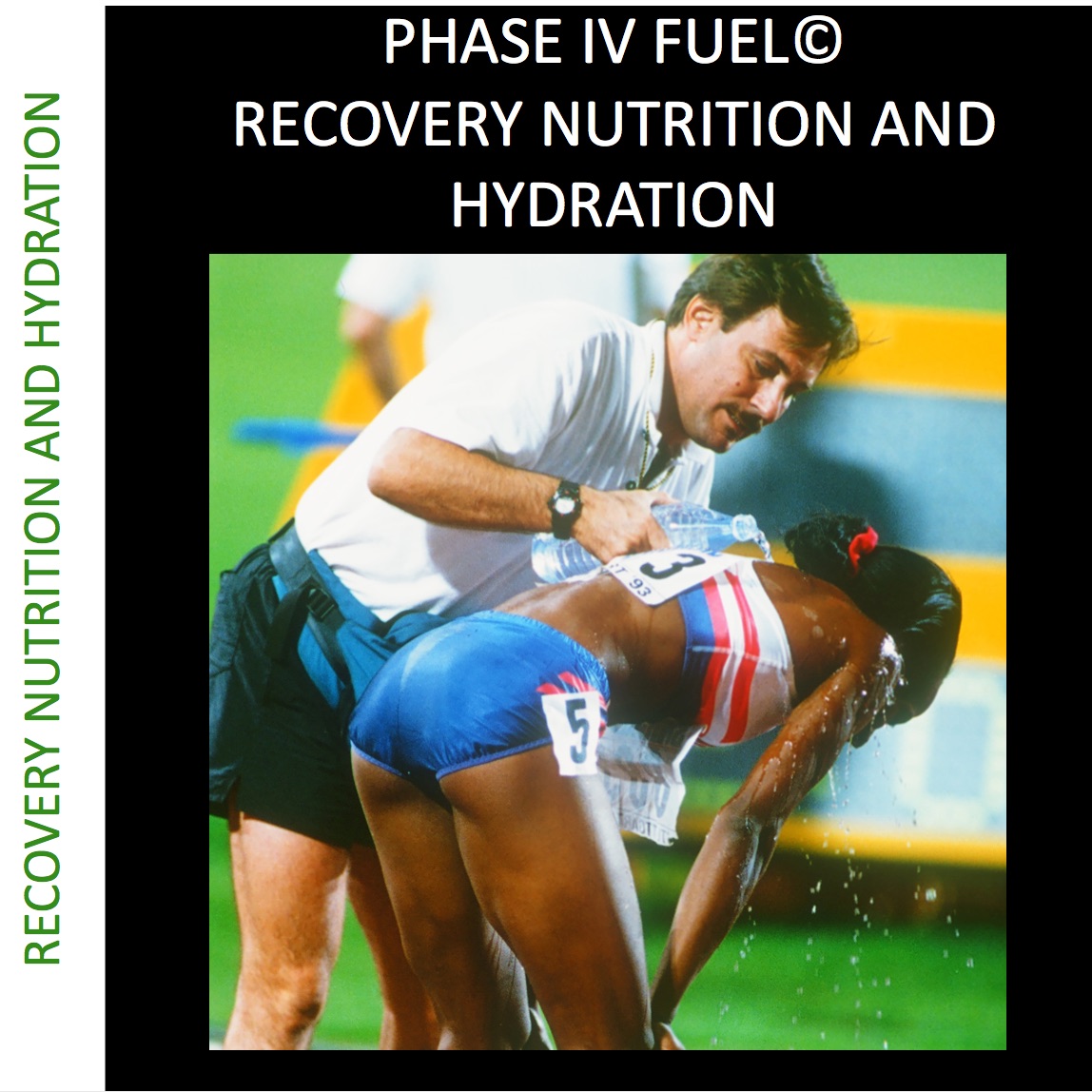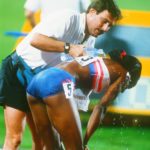The scene in the medical tent tells the story as IV bags hang next to each cot where exhausted, dejected athletes receive assistance. The medical team explains the typical scenario that played out on the course hoping an educated athlete is the best way to avoid a repeat of what turned out to be a disastrous day for so many. A few were even taken to the hospital suffering severe heat illness.
The doctor explains that exercise in extreme heat puts great stress on numerous physiological systems of the body. It can severely debilitate athletic performance, create bodily damage or illness and in extreme cases, even cause death. However, if an athlete is educated to how the body reacts to heat they can combat this sometimes unpredictable environmental stress intelligently with scientific measures to prevent it from ruining their preparation for a great performance.
He further explains that body temperature rises due to internal and external factors. Internally heat is generated during the metabolism of food sources as eighty percent of all energy from carbohydrates, fats and proteins are eventually transformed to heat. Furthermore, muscular contractions produce heat, as does the mechanical friction of tendons and joints as they move thousands of times during the race. If this heat is not transported to the skin and dissipated to avoid overheating risk of multiple system failure builds quickly. External factors play a role as well and while it is common knowledge that in warmer weather it is more difficult for the body to dissipate heat than in cooler weather few people realize that in very warm weather the body will gain heat from the environment. Since the skin temperature usually varies between 93°F and 98°F; when the air temperature is greater than 99°F the air actually heats the body more. Direct sunlight increases body temperature further when the body absorbs radiant heat. Humidity magnifies the effect of hot weather by rendering ineffective the very mechanism the body relies on to dissipate heat; i.e., sweating.
The Physiological Response to Heat
Receiving sensory feedback from body receptors both internal and external, the brain senses increased temperatures as a stress to homeostasis. The brain therefore orchestrates a far-reaching bodily response to dissipate heat in an attempt to maintain normal physiological function. This begins with the release of the stress hormones cortisol, epinephrine and norepinephrine, which set off a systematic series of events within the body to offset the heat. In an effort to dissipate heat from the working muscles and the core; blood is shunted by a magnitude of 30-40% from the internal organs to the skin and superficial muscles. However, this is not enough. The heart must increase the volume of blood pumped with each contraction (cardiac output) from 6 liters to 25 liters per minute to get more heat-carrying blood to the skin where it can be cooled. Simultaneously, the brain directs a decrease in kidney production of urine to spare fluids.
The cooling of blood near the skin occurs when millions of sweat glands located just below the surface increase sweat production to moisten the skin. The body is cooled when air moving over the skin evaporates the sweat taking heat with it. In hot, dry conditions sweat evaporation results in 85-90% of all heat dissipation during exercise. In humid conditions however, this efficient mechanism is handicapped as sweat is less likely to evaporate in the moist air. The sweating mechanism continues in vain to cool the body and quickly results in dehydration.
The Physiological Stress of Overheating
The body is very efficient at dissipating heat and under everyday conditions these mechanisms go a long way in preventing overheating. However, these physiological responses can be outpaced with sustained exercise in the heat. Nature apparently relies on the sensibility to stop laboring when one feels overheated. For athletes, soldiers and workers this is sometimes not an option and serious health problems can quickly arise. The circulatory system is taxed when excessive sweating depletes the volume of fluids in the blood and blood is shunted to the periphery. These events lead to a 20% decrease in the circulatory volume in the vascular system. The heart beats faster and harder to deliver the same amounts of nutrients and oxygen to the working muscles.
The cardiac and circulatory stress is further elevated by the loss of electrolytes in the copious amounts of sweat produced in hot weather. Electrolytes are essential to nerve impulses and the resulting muscular contractions that produce movement. Electrolyte depletion and the resulting breakdown in performance begin slowly but degrade quickly if intensity of exercise is not adjusted and electrolyte supplementation and re-hydration is not executed.
Further performance degradation occurs when overheating causes a shift in muscular metabolism from fats (aerobic) to carbohydrates (anaerobic) energy production. Carbohydrate metabolism however produces fatigue associated with lactic acid production. Carbohydrate stores are quickly depleted leading toward total system shutdown called “bonking.”
Prevention of Overheating and Performance Degradation
The prevention of overheating problems during exercise begins in the Base Training Phase of your training (see Triathlon January ’04 issue) where improved fat burning capacity of muscles diminishes the detrimental effects of the unfavorable shift in muscle metabolism from fats to carbohydrates. Early season strength training and skill developing drills improve efficiency of joint stability and movement. Together these athletic attributes prevent unnecessary heat production associated with wasted motion.
Later in the season specific heat acclimation measures will greatly improve your capacity to perform in the heat. *(see Sidebar)
Proper Hydration and Supplementation for Prevention of Heat Illness
Staying well hydrated at all times maintains the quality of performance in workouts and competition. Twenty four – thirty six hours prior to the race you should be hydrating and liberally salting foods. Pre-hydration is critical in the prevention of heat related problems. At least two hours before exercise drink 20 ounces of fluid with electrolytes and carbohydrates in a 10% concentration to increase absorption rates. Cold fluids are absorbed quicker than room temperature beverages.
During exercise sweat loss can range from .8 to 1.4 liters per hour and therefore dictates replenish rates of similar volumes. However, the rate that fluids leave the stomach is .8 to 1.2 liters. So, to prevent bloating or the potentially deadly condition of electrolyte imbalance called hyponatremia; hydrate with volumes that do not exceed your absorption rates and always use electrolyte replacement drinks vs. plain water before and during long bouts of exercise.
Catastrophic heat related effects on your performance can best be avoided with knowledge of how heat stresses the body and intelligent scientific training methods that include proper Base Training and disciplined hydration and supplementation practices. Now- go enjoy the day!
A good general guideline would be to consume a sports drink and/or electrolyte supplementation containing 200-500 milligrams of sodium chloride per hour. At the first sign of cramping or performance degradation reduce your pace, drink liberally and supplement with electrolytes or salty foods immediately. You may be able to salvage the day.
*SIDEBAR:
Heat Acclimation
Gradual heat acclimation improves your capacity for performing in the heat by creating these adaptive responses with full acclimation occurring with 14 consecutive days of training in the heat.
Increased blood plasma volume by 3-27%
Decreased heart rates by 15-25%
Improved sweat sensitivity and sweat rates by 200%
Decreased electrolyte loss through sweat and urine
Simulated heat training can be achieved by exercising in warm clothes or in a warm room (not a sauna). Intensity must be at least 50% of VO2 max and gradually build up to 90 – 100 minutes.
PHASE IV FUEL© Recovery Nutrition

What we do will increase the fitness value of all your workouts. What you put in your tank before, during and after workouts greatly impacts the fitness goal. Recovery nutrition is built in to all Periodization training models because it’s needed whether you feel hungry thirsty or not. After your workout, your body is in a state of stress and needs nourishment. Usually after exercise your body will be dehydrated, your blood insulin levels will be low, Cortisol and other “breakdown” hormones will be high, your glycogen (fuel stores) will be low or depleted, and your muscles will be in a state of breakdown. Your recovery nutrition should reverse all of the above and restore your to a hydrated fueled, recovered and muscle building state.
Learn what science teaches about the guidelines for an effective recovery drink. Whether you want to lose weight, put on muscle, or simply perform at the best your genetics will allow, your nutrition must support your workouts, competitions, and your lifestyle! We use real science, not gimmicks or fads to address your personal physiology and nutritional needs. The time to figure out the best mix of calories and fluids for your personal physiology is now!







